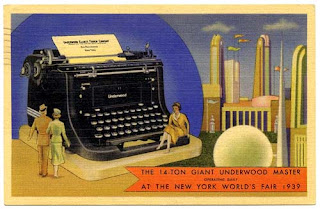Technology in modern times has been advancing very rapidly. Every year it seems there is a new piece of technology that everyone becomes obsessed with. This was also true for the people back in the 19th century. The invention of the typewriter was something that caught peoples attention.
Before the typewriter the only other way of recording words on paper was to write them down. The time and effort it took to do that was unbearable and wouldn't come out as neat as typed text looks. There would be men in businesses who's only job was to copy down documents or write letters because it was taking up such a large amount of time. It was a very tedious task, writing with pen, and making sure to get everything right but also be sure that it was eligible to read.
The typewriter solved all of those problems. In the year 1828 William Austin Burt put a patent on a machine he called the "typographer". This is considered the first typewriter to be made into existence.
In 1868, a group of men got together and patented their version of the typewriter. Christopher Latham Sholes, Frank Hall, and Carlos Glidden from Milwaukee, Wisconsin. After a couple failed attempts at trying to manufacture the typewriter they were taken over by Remington and Sons in 1873.
These men worked together and were the first to release a commercially successful typewriter. They called it the
Sholes and Glidden typewriter (also known was the Remington No. 1) and it was released out to the public in 1874.
It was a revelation. The Sholes and Glidden typewriter was quickly adopted by large business corporations and was able to gain instant popularity.
It was actually this typewriter that set the way our keyboards are set up today. Starting at the top with QWERTY and ending with VBNM.
A quote from the Salt Lake Herald from an article in 1884 shows just how much the typewriter changed the face of businesses. The quote reads,"Perhaps no invention of modern times has done so much to relieve business men of the great amount of pen-work drudgery to be done in every business, as the standard Remington type-writer."
The typewriter can also be credited for
bringing women into offices and businesses because they needed to have someone trained and operating the typewriter. The typewriter came at the perfect time allowing women to start having their own businesses during the women suffrage movement.
Even though this typewriter was the first of its kind there were a lot of practical problems that it had. The biggest concern was that it was only able to type in capital letters. It was also known as a "blind-writer" because the person typing could not see what their work looked like. They would not know if there was a mistake until they were all done and took the paper out to examine it.
All of these problems were solved when the second edition of this same typewriter came out. The
Remington No. 2 was a revised version of the first model.
It had a shift key that would allow users to type in upper and lower case. It was the first typewriter that was mass produced and really paved the way for the increasing interest in typewriters. It came out four years after the Remington No. 1 in 1878. It was still a blind-writer like the original model but you could lift up a little flap at the top of the machine to check the paper and see how it looked.
As time moved on more and more variations of the typewriter started to come out. Shortly after the Remington No. 2 the
"Underwood 1 Typewriter" came out in 1897.
This was the first typewriter where the typist could fully see the paper and the words they were typing out. It was created by John T Underwood in 1895.
Mark Twain was the first novelist to use a typewriter. He called it a
"newfangled typing machine". He fell in love with the machine after being impressed by how fast it could write words. His book "Life on the Mississippi" released in 1883 was the first book published that was fully typed on a typewriter.
Then in 1925 Remington came out with its first electric typewriter.
Up until computers, typewriters were the only way of neatly getting something down on paper and fast. Throughout the years typewriters advanced and got more practical.
Typing is now nothing compared to what it was when the first typewriter was released back in 1874. We now merely tap the letters we want to write out letters, books, essay, etc.
The typewriter changed the face of writing in America and all over the world. Without it technology wouldn't be where it is today. The typewriter was another stepping stone to the new innovations that were rising in our country at the time.









No comments:
Post a Comment